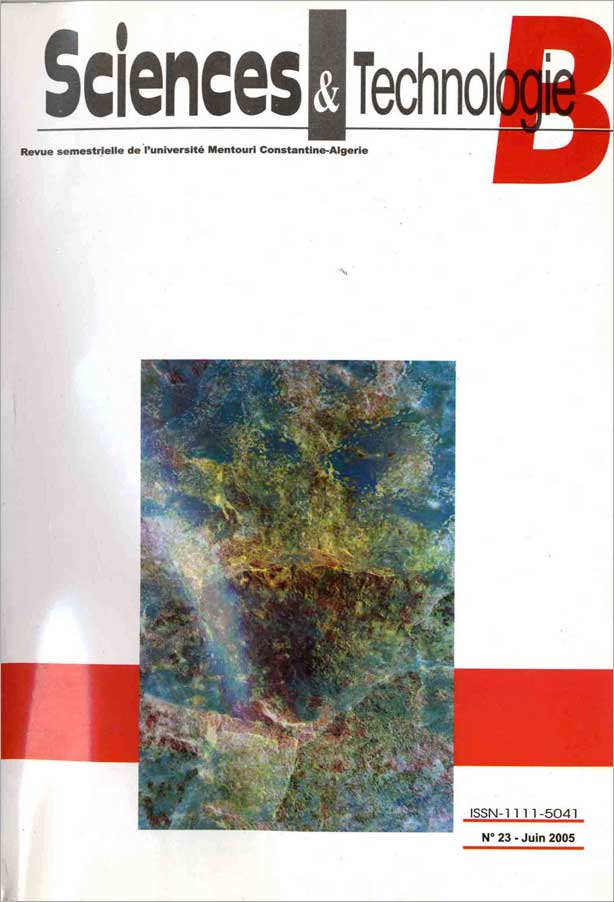PREVISION NUMERIQUE DE JETS TURBULENTS TOURBILLONNANTS CONFINES AVEC LE MODELE (K-ε)
Keywords:
Chambre de combustion, jet turbulent, tourbillonnement, modélisation numérique, modèle (K-ε), modèle des tensions de Reynolds, combustion chamber, turbulent jets, swirling, simulation, (K-ε) modelAbstract
The present survey consists of numerical prevision of two turbulent jets with swirling in a combustion chamber. The simulation is based on numerical method of finite volumes and finite differences of Patankar. The mathematicalmodel used is two equations of turbulence model (K-ε). The iterative sequence adopted SIMPLE algorithm for a resolution of equations
system. A calcul is realized by a numerical code adapted to present configuration. The numerical results were compared with experimental results of the literature [6]. Performances of model (K-ε) have examined with another numerical result study such, as the used model is the Reynolds Stress Turbulence Model (RSTM). This model necessitudean important number of equations for a calcul of Reynolds Stress.A good according was qualitatively observed for the predictions of the (K-ε) model.
References
-ANDRREW.T and CHRISTOFER K.W: Computation of
Turbulent Axis metrical and no Axis metrical Jet Flows Using the (K - ( ) Model (FLORIDA state University TALLAHASSEE FLORIDA 32306-3027, AIAA Journal. Vol 34, No.2, February 1996).
-CHIN, SHUN LIN: Numerical Calculations of Turbulent
Reacting Flow in a Gas-Turbine Combustor (National Aeronautics and Space Administration, Cleveland Ohlio, Av
.
-DAMOU.M : Simulation Numérique d'Ecoulement Turbulent avec Tourbillonnement dans une Chambre de Combustion (premier colloque sur les moteurs et l'énergétique (COME ' 96), Blida 14,16 et 19 janvier 1996).
-DINH. VONGOC : Méthodes Numérique d'Intégrale Locale
sur les Volumes Finis (Ecole de Génie Université de MONCTON. CANADA).
-HABIB.M.A and WHITELAW.J.H: Velocity Characteristic
of Confined coaxial Jets withand Without Swirl (Imperial College of Science and Technology Mechanical Engineering Dept, LONDON, ENGLAND, Journal of Fluid Engineering March 1980, Vol 102/47).
-HOGG.H and LESCHZINER.M.A: Computation of Highly
Swirling Confined Flow With a Reynolds Stress Turbulence
Model (University of MONCHESTER, ENGLAND UNITED KINGDOM, 27 Nov 1989).
-JONES.W.P and LAUNDER.B.E: The prediction of laminarization with a two-equation model. Int. J. Heat mass
transfer, Vol. 15 P.301. 1972
-LAUNDER.B.E and SPALDING.D.B: Mathematical Models of Turbulence (Dept of Mechanical Engineering, Imperial Collogue of Science and Technology, LONDON. England 1972).
- MONGIA.H.C, PATANKAR.S.V, MUSTHY.S.N, SULLIVAN.J.P and SAMUELSEN.G.S: Aero thermal Modeling Program - Phase II (University of California at Irvine, NASA contract NAS3 - 24350).
- NADJI.H : Modélisation et Calcul de l'Ecoulement Turbulent dans un Jet Tournant Libre. (Thèse de Docteur de
me Cycle, Université de LILLE, FRANCE 1984).
- NALASAMY.M: Prediction of Recirculation Zones in
Isothermal Coaxial jet Flows relevant to Combustors (University Space Research Association Boulder, Colorado NASA 1987)
- NIKJOOY and MONGIA: Fuel Injector-Air Swirl Characterization Aero thermal Modeling Phase II (Final Report Volume II NASA Prepared for Lewis
Research Center NAS3 - 24350. 1993).
- PARK.C.D and CHENT.L.D: Experimental Investigation
Turbulent Jets Part I: Single -Phase Data;(University Of IOWA, IOWA City AIAA Journal Nov 1989).
- SHARIF.M.A.R and WONG.Y.K.E: Evaluation of the
Performance of Three Turbulence Closure Models in the Prediction of Confined Swirling Flow (Dept of Engineering
Science and Mechanics, University of Alabama USA Received 14 October 1992 in Received Form 3 January 1994).
- SUHAS, PATANKAR.S.V: Numerical Heat Transfer and
Fluid Flow (Hemisphere Publishing Corporation, WASHINGTON, New York, LONDON).
- SING.S.N, AGRAWAL.D.P, MALHATRA.R.C and RAGHVA.A.K: Mean Velocity Distribution of Contra Swirling Coaxial Confined Jets (Dept of Applied Mechanics Indian, Institute of Technology, HANZKHAS, NEW DELHI 110016 INDIA).
Downloads
Published
Issue
Section
License
Les auteurs publiant dans cette revue acceptent les termes suivants :- Les auteurs détiennent le droit d'auteurs et accordent à la revue
le droit de première publication, avec l’ouvrage disponible simultanément [SPÉCIFIER LA PÉRIODE DE TEMPS] après publication, sous la licence Licence d’attribution Creative Commons qui permet à d'autres de partager l'ouvrage en en reconnaissant la paternité et la publication initiale dans cette revue. - Les auteurs peuvent conclure des ententes contractuelles additionnelles et séparées pour la diffusion non exclusive de la version imprimée de l'ouvrage par la revue (par ex., le dépôt institutionnel ou la publication dans un livre), accompagné d'une mention reconnaissant sa publication initiale dans cette revue.
- Les auteurs ont le droit et sont encouragés à publier leur ouvrage en ligne (par ex., dans un dépôt institutionnel ou sur le site Web d'une institution) avant et pendant le processus de soumission, car cela peut mener à des échanges fructueux ainsi qu'à un nombre plus important, plus rapidement, de références à l’ouvrage publié (Consulter The Effect of Open Access).

